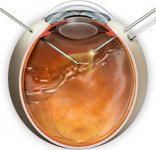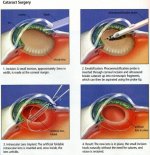Roadster Renovations
New member
Update
Well, everything went pretty well. Only glitch was when the cataract doctor put the lens in upside down. They now fold it in half to put it in. This way they don't have to make a large incision. Well, when it open up it evidently opened facing down. Opps. Took a few minutes for the retinologist to help the other doctor and get it out and placed correctly. Once they got that done a few sutures and done. Then the real work started. The retinologist insert two tools into my eyeball; one a light and the other a little needle with a vacuum attachment. She then proceeded to vacuum 95% of the floaters. The only ones she left were the ones too close to the retina to safely remove. The last step was too use a very small laser in the hole to finish the spot welds to attach the retina that she had been unable to get back in July with the larger, external machine.
The neat thing about this was that it was done with me awake and my eye blocked and unmovable. I was fascinated to see that little vacuum move around a chase those floaters around and make them disappear. I few small sutures in each penetration and she was done. All in all, both surgeries took a total of two hours. I cannot say enough about the Doctors and staff of the Indianapolis VA hospital. They are AWESOME!
Here is a pictures of what they did in the second surgery:

Thanks for all the well wishes. Looking at the diagram i see three holes were made. The third one is to replace the fluid that was taken out with the debris. I go back in the morning to have the pressure patch removed by them. Should be able to see how much improvement. I wouldn't want to wish this surgery on anyone, but in my case the cataract was getting worse, I had so much debris in my eye field my vision was 20/400, so it was worth the risk. All I can say is have your eyes checked annually and if you have any ink jets suddenly in your vision field, contact the ER immediately. A detached retina can be repaired if caught in time. Very small window though!
Well, everything went pretty well. Only glitch was when the cataract doctor put the lens in upside down. They now fold it in half to put it in. This way they don't have to make a large incision. Well, when it open up it evidently opened facing down. Opps. Took a few minutes for the retinologist to help the other doctor and get it out and placed correctly. Once they got that done a few sutures and done. Then the real work started. The retinologist insert two tools into my eyeball; one a light and the other a little needle with a vacuum attachment. She then proceeded to vacuum 95% of the floaters. The only ones she left were the ones too close to the retina to safely remove. The last step was too use a very small laser in the hole to finish the spot welds to attach the retina that she had been unable to get back in July with the larger, external machine.
The neat thing about this was that it was done with me awake and my eye blocked and unmovable. I was fascinated to see that little vacuum move around a chase those floaters around and make them disappear. I few small sutures in each penetration and she was done. All in all, both surgeries took a total of two hours. I cannot say enough about the Doctors and staff of the Indianapolis VA hospital. They are AWESOME!
Here is a pictures of what they did in the second surgery:
Thanks for all the well wishes. Looking at the diagram i see three holes were made. The third one is to replace the fluid that was taken out with the debris. I go back in the morning to have the pressure patch removed by them. Should be able to see how much improvement. I wouldn't want to wish this surgery on anyone, but in my case the cataract was getting worse, I had so much debris in my eye field my vision was 20/400, so it was worth the risk. All I can say is have your eyes checked annually and if you have any ink jets suddenly in your vision field, contact the ER immediately. A detached retina can be repaired if caught in time. Very small window though!


